Journal of Service Science and Management, 2018, 11, 543-564
http://www.scirp.org/journal/jssm
ISSN Online: 1940-9907
ISSN Print: 1940-9893
Smart Library and Smart Campus
Hubert C. Y. Chan1, Linus Chan2
1The Hong Kong Polytechnic University, Hong Kong, China
2University of Montana, Missoula, USA
How to cite this paper: Chan, H.C.Y. and
Chan, L. (2018) Smart Library and Smart
Campus. Journal of Service Science and
Management, 11, 543-564.
https://doi.org/10.4236/jssm.2018.116037
Received: October 31, 2018
Accepted: November 25, 2018
Published: November 28, 2018
Copyright © 2018 by authors and
Scientific Research Publishing Inc.
This work is licensed under the Creative
Commons Attribution International
License (CC BY 4.0).
http://creativecommons.org/licenses/by/4.0/
Open Access
Abstract
The consequence of digitalization, Internet proliferation, and technology ad-
vancement, our way of teaching and learning has been changing. The role of
library has to be converted into a place for discourse, peer collaboration, so-
cial learning, and exhibition concourse. Some scholars believed that the fu-
ture Library is tied to the technological development of Web4.0 which is cha-
racterized by the terminology of Convergence, Remixability, Standardization,
Participation, Usability, Economy, and Design. This concept has been ex-
tended to Campus. Some universities have started to adopt the latest tech-
nology to convert their Campus and Library into Smart ones for the interests
of students. The findings of this paper support that the latest development of
Smart Campus and library aligns with the new trend of education system, and
creates positive impact on the competitiveness of a city. The applications in
Smart Camus and Library in reality are also revealed.
Keywords
Smart Library, Smart Campus, Connectivism, Education System,
Competitiveness
1. Introduction
In the digital age, information can be disseminated through a variety of media
besides hardcopy books or journals. The traditional role of library which is con-
sidered as an institution of information supply with a specific information
structure that operates as an intermediary between supply and demand on di-
verse (information) markets (Hanekop and Wittke, 2006) [1] has been changing
from passive mode as Web1.0 to active mode as Web2.0 onward. The changing
natures of library will not only reflect that of the web but will also feature new
attributes based on the uniqueness of libraries (Noh, Y., 2015) [2]. The characte-
ristics of Web2.0 are rich user experience, user participation, dynamic content,
DOI: 10.4236/jssm.2018.116037 Nov. 28, 2018
543
Journal of Service Science and Management
�
H. C. Y. Chan, L. Chan
DOI: 10.4236/jssm.2018.116037
metadata, scalability, openness, freedom and collective intelligence by way of
user participation (Best, 2006) [3] while Library2.0 is defined as a subset of li-
brary services designed to meet user needs precipitated by the direct and peri-
pheral effects of Web2.0 (Habib, 2006) [4]. Web2.0 was further developed into
Web3.0. It combines the semantic web, Web2.0 applications and artificial intel-
ligence, creates the opportunities and possibilities for the use of semantic tagging
and annotation for the social web. This social semantic characteristic has been
emphasized in library 3.0 (Alotaibi, 2010) [5]. Web3.0 is being evolved to
Web4.0. Web4.0 is defined as an intelligent electronic agent, symbiotic, ubiquit-
ous, and a machine which will be developed up to the level of human brain with
advanced nanotechnology and human interaction interfaces (Patel K, 2013) [6].
We are already living in the era of Library 3.0, and Noh, Y (2015) [2] suggested a
Library 4.0 model based on the development of Web4.0. He posited that Library
4.0 must include not only software-based approaches but also technological en-
vironment development such as maker space, Google Glass, context aware
technology, digitalization of contents, big data, Cloud computing, and aug-
mented reality. This concept has been extended to the whole Campus. Educa-
tionists believe that this Smart evolution can strengthen the learning capacity
and capability of students. As we are moving toward this trend, would it align
with that of the desirable education system development? The purpose of this
paper is to examine the alignment of these two trends, and reveal the current
technologies which are already deployed in the market.
2. Education System
South Korea, Japan, Hong Kong and Singapore, and Finland are considered to
dominate the conversation of good education system
(https://www.linkedin.com/pulse/education-systems-around-world-comparison
-sashi-gundala) [7]:
South Korea: South Korea spends 8% of its GDP on education as compared
to a 6% average of other OECD participating countries. The main focus of their
system is primary education. They make a good start with students, which carry
them through the rest of their educational life. The students are known to go to
school seven days a week. Parents are very involved and are willing to spend a lot
of money to get their child the education they need. Teachers have to be highly
qualified and are also highly paid. It is one of the coveted career choices in South
Korea.
Japan/Singapore/Hong Kong: All three systems have a technology-based
education structure. Science, Technology, Engineering, and Math (STEM) have
been proliferating in primary education. They are also similar to South Korea in
the fact that their main focus is also primary education and they spend a good
percentage of their GDP on education. The primary, secondary and higher edu-
cation levels are exemplary in their approach and work. Student retention is a
common practice. The education system has moved instruction further away
from the rote memorization and repetitive tasks on which it had originally fo-
544
Journal of Service Science and Management
�
H. C. Y. Chan, L. Chan
cused to deeper conceptual understanding and problem-based learning. The
Singapore’s ministry of education’s recent policy of “Teach less, learn more” is
highly popular and has catapulted its education system onto the top rungs in the
world. The trend is adding Art into the STEM, and advocating the concept of
STEAM.
Finland: School does not begin for children until they are 7 years old. There is
no homework and no standardized testing until they reach high school. They
have shorter school days. All schools follow a national curriculum. Students and
teachers spend less time in schools in comparison to their American counter-
parts. Finland also provides three years of maternity leave, subsidized daycare
and pre-school for 5 - 7 year olds where the emphasis is on playing and socializ-
ing.
Canada: They focus on three main parts: literacy, math and high school
graduation. With a clear vision, they have created a transparent system in colla-
boration with administrators, teachers and the union to create a curriculum and
methodology that is successful. The system encourages teamwork, quality edu-
cation, continued teacher training, transparent results and a culture of sharing
best practices. The teacher morale is also high because their pay is acceptable,
working conditions are favorable, facilities are good and there are all kinds of
opportunities for teachers to improve their practice. Most importantly, perhaps,
there is discretion for teachers to make their own judgments.
The share of national universities in the top-200 of Hong Kong, Singapore,
Canada, Finland, South Korea, and Japan are 18.2%, 4.5%, 4.3%, 2.3%, 0.8% and
0.3% respectively while their Global Competitive Index
(https://www.weforum.org/agenda/2017/09/what-is-economic-competitiveness/)
[8] are all above 5 as shown in Chart 1 below. It shows the current status but its
policy, ultimate resource (teachers), openness and freedom must be aligned with
the future needs [9] if they want to keep and improve their future competitive-
ness. The overall results of worldwide educating for the future index [9] has been
listed for comparison. High Education and training is one of the 12 pillars of
Competitiveness. This pillar measures secondary and tertiary enrollment rates as
well as the quality of education as evaluated by business leaders. However, the
Happy Planet Index is the other way round with the exception of Finland. It
seems that no homework and no standardized testing in primary school do en-
hance Happiness. Competiveness and happiness can co-exist if our Education
system is properly designed. In fact, Educational curricula cannot be remain
unchanged, a career paths change faster, and are less linear than ever before ac-
cording to the World Economic Forum’s 2017 white paper [10] “Realizing Hu-
man Potential in the Forth Industrial Revolution”. There is a consensus that no
single skill set or area of expertise is able to sustain a long term career in the
economics of the future. Educational institutions need to provide both in-depth
subject knowledge as well as inter-disciplinary connections. The Future core
skills of the 21st century are complex problem solving, critical thinking, creativi-
ty, collaboration, and digital literacy. Globalization with greater integration
545
Journal of Service Science and Management
DOI: 10.4236/jssm.2018.116037
�
H. C. Y. Chan, L. Chan
Chart 1. Comparison of top-200 universities, global competitiveness index, happy plant index and the worldwide educating for
the future index. (Sources: The Worldwide Educating for the Future Index (2018), https://yidanprize.org/research/ [9];
https://www.weforum.org/agenda/2017/05/which-countries-provide-their-citizens-with-the-best-higher-education [22]; World
Economic Forum, The Global Competitiveness Report 2017-2018 [23]; http://happyplanetindex.org/ [24]).
between economies across the globe and digital technology is driving younger
generation to face a significantly different future world. They have to be
equipped themselves new style of skill, namely Interdisciplinary skills, Creative
and analytical skills, Entrepreneurial skills, Leadership skills, Digital and tech-
nical skills, and Global awareness and civic education [9]. These skills are ideally
developed in early stage and then refined at colleges and universities, and life-
long learning. The curricula must be updated and adapted on a regular basic
across industries according to the shifting demand in the labor market
(https://toplink.weforum.org/knowledge/insight/a1Gb0000000LPFfEAO/explore/
summary) [11]. This is the principle of Connectivism which is considered to be
the learning theory of the digital age, “a successor to behaviorism, cognitivism,
and constructivism”. It is an integration of the principles explored by chaos,
network, and complexity and self-organization theories (Siemens, 2004) [12].
The principles emphasize on connections with information sources, different
DOI: 10.4236/jssm.2018.116037
546
Journal of Service Science and Management
�
H. C. Y. Chan, L. Chan
fields, and ideas. This connection can be made through social networks which
are built on the premise of collaboration and sharing. They are ideal for connec-
tivity particularly in external learning situations that are not always available, or
feasible, in face-to-face classrooms (Mallon, 2013) [13]. This intangible asset
produced by social relationships as a result of social networking is defined as so-
cial capital (Coleman, 1994) [14]. It has been indicated that frequent library us-
ers have a higher social capital than those who use the library less often (Johnson
and Griffis, 2009) [15].
Modern libraries represent ideal environments for supporting connected
learning. They are centers for knowledge creation and sharing, they support
self-directed and interest-based learning, and they are inclusive public spaces
that bring many different groups together. Once primarily thought of as infor-
mation providers or repository managers, libraries have undergone a transfor-
mation (Braun et al., 2014 [16]; Garmer, 2014 [17]; Ito & Martin, 2013 [18]).
Connected learning is an educational framework that emphasizes learning expe-
riences that are “socially embedded, interest driven and oriented toward educa-
tional, economic, or political opportunity” (Ito et al., 2013, p. 4) [19]. Connected
learning emphasizes openly networked connections outside of traditional learn-
ing spaces. Libraries can help forge those connections through social and digital
media, through peer culture and teens’ social lives, and by finding new audiences
and outlets for youth’s creative work (Hoffman et al., 2016) [20]. Public libraries
may no longer be needed to provide formal community information, but they
can engage as information shepherds with local community service agencies in
informal community information provision (Gorichanaz and Turner, 2017)
[21]. On the other hand, School libraries are centers of innovation while libra-
rians are ambassadors of technology, makerspaces, STEM programming, and
independent research. They are connectors and collaborators, working exten-
sively alongside teaching faculty and engaging with the outside community. The
same concept has been extended to Campus.
3. Smart Campus
Technological advances have enhanced education to new heights, where some
universities can afford to upgrade their facilities, including Smart libraries. As
university libraries are repositories of research in virtually all fields and libraries
are accessible for the next generation of working adults, improving libraries
would greatly advance society in general (Soria, Fransen, & Nackerud, 2013)
[25]. However, education and student life goes beyond the library. Education is
more than effective access to information. The connectivity of devices enabled
by Internet of Things (IoT) can no doubt benefit the whole campus. Institutions
that adopt digital infrastructure and provides services to its users can become a
Smart Campus. These include capitalizing on IoT, RFID, GPS technology (Sari
et al., 2017) [26]. In this section, we outline how several initiatives in developing
a Smart Campus strengthen learning capacity, happiness, and competitiveness
for universities. An overview picture is shown in Figure 1.
547
Journal of Service Science and Management
DOI: 10.4236/jssm.2018.116037
�
H. C. Y. Chan, L. Chan
Figure 1. Smart campus.
DOI: 10.4236/jssm.2018.116037
3.1. Digitally Augmented Learning Spaces
Learning in universities tends to occur in classrooms or lecture halls. Generally
speaking, the professor would be in front of the lecture hall and present infor-
mation in front of dozens, if not hundreds, of students. The professor could use
a whiteboard or PowerPoint for ease of presentation, or even use science expe-
riments to illustrate a phenomenon. Even though professors in smaller class-
rooms can more easily interact with individual students or small groups of stu-
dents, tools in these traditional learning spaces are limited. Relying on Power-
Point, books, iClickers, and the occasional hands-on could greatly benefit from
additional technology (Mayer et al., 2009) [27]. Although this type of learning
has worked in many fields that centers around texts and the exchange of ideas
that can be adequately communicated via class discussions or essays (e.g. Eng-
lish, philosophy, communication), many fields that involve micro or macro vi-
sualization (e.g. STEM) would need digitally augmented classrooms. Universities
that adopt these technologies would be more competitive as students cannot
learn the same way by themselves.
On a small scale, the Internet of Things allows physical learning spaces to be
digitally augmented (Price & Rogers, 2004) [28]. Given that physical engagement
increases involvement in learning, and augmented classrooms have shown to
pique students’ interests, this technology would enhance learning capability.
Traditional lecture halls could be redesigned by arming them with SMART-
boards, virtual reality headsets, or augmented reality (Wu et al., 2013) [29].
SMARTboards can replace overhead projectors and allow teachers to enhance
548
Journal of Service Science and Management
�
H. C. Y. Chan, L. Chan
their lessons by integrating computers, video cameras, microscopes, and online
resources with the board. These SMARTboards can serve as digital whiteboards;
teachers can project their PowerPoint slides whilst writing on them. Teachers
can bring up previously saved slides via QR codes and hand out virtual copies of
class notes without a printer. Students can see the board update on their screens
in real-time, and even contribute to the whiteboard by drawing on their own
screens. They can customize their digital class notes with their classmates’ notes,
animations, or links to online resources.
Besides SMARTboards, VR technology lets students explore ideas, play games,
view films, visualize complex data, interact with 3D objects that are too fragile or
microscopic, and visit other countries virtually (Merchant et al., 2014) [30]. Stu-
dents interested in painting can use “Tiltbrush” to paint in a variety of colors,
brush styles, and in a 3D setting without wasting canvases. Tiltbrush allows stu-
dents to navigate around their painting, import previously drawn art into their
work, and easily share their work. Medical students can use “Share care”, which
visualizes various human organs (e.g. brain, stomach, and kidney) at various le-
vels of analysis. Students can rotate these organs and learn about the human
body in ways that no traditional textbook can provide. Organs in Share care have
labeled descriptions on them, thereby supplementing visuals with factual infor-
mation. Lamb et al. (2018) [31] found that learning science concepts are using
VR technology, specifically DNA, increased students learning due to the real-
ism and 3D modeling. But it doesn’t stop there. VR has been used as an effec-
tive way to simulate dangerous scenarios such as earthquake or evacuation
training (Feng et al., 2018) [32]. Instead of flyers or posters on what to do
during these dangerous situations, immersive VR can help humans envision
the situation, which includes moving, crouching, turning, and simulate quick
reactions to fake stimuli. Immersive VR can provide better memory recall abili-
ty compared to non-immersive VR conditions (Krokos, et al., 2018) [33]. Their
research showed that participants felt more focused on the task due to better
immersion experience.
Lastly, classrooms can be augmented with computer-generated stimuli that
appear in reality, namely augmented reality. AR technology can be cost-effective;
students can download apps and utilize AR through their smartphone cameras.
AR merges reality with fake stimuli to enhance learning; data appear over reality
so students can observe artificial images in a real-world setting. There are cur-
rently AR apps for almost any subject, such as geometry, translation, math, and
art. For instance, users of the free Google Translate app can translate text into
other languages in real-time by capturing the text on their smartphone.
Together, digitally augmented classrooms strengthen learning capacity, hap-
piness, and competitiveness of universities. Admittedly, incorporating these
technologies is costly and time intensive but the investment brings long-term
benefits. Traditional classrooms can be replaced by online courses, but aug-
mented classrooms cannot be. While augmenting digital classrooms is one way
549
Journal of Service Science and Management
DOI: 10.4236/jssm.2018.116037
�
H. C. Y. Chan, L. Chan
DOI: 10.4236/jssm.2018.116037
Smart Campus can assist education, smart campuses enhance learning in other
ways as well.
3.2. Enhancing Student Learning and Teacher’s Instruction
Learning is both the student and instructor’s responsibility. Professors are re-
sponsible for delivering and facilitating content delivery and application while
students are expected to engage in the material. Since many university classes are
so big that taking attendance becomes a daunting task, it is unrealistic to expect
professors to remember every student’s face or call out each name one by one.
Yet, keeping track of attendance is useful because participation is essential in
some courses and attendance is a predictor for class success (Credé et al., 2010)
[34]. Fortunately, teachers can accurately and efficiently monitor students’ class
attendance via RFID tags in student ID cards. Another option is using Blu-
etooth bacon installed in each classroom coupled with a mobile App since al-
most all students are equipped with smart phone.
Teachers can also use IoT technology to monitor students’ learning in other
ways, all of which could be computer-automated and presented to teacher in an
efficient manner. Teachers can monitor their student’s attendance in other
classes to find out the student’s overall engagement with academics. If a student
consistently attends one class but consistently misses another, it may indicate the
amount of effort and dedication the student is putting in respective classes.
Teachers can use this data to track their own teaching performance, with the as-
sumption that students who regularly attend class are expected to do better.
Moreover, teachers can analyze the types of words and thoughts the students are
often engaged in when posting on class discussion boards. Programs such as the
Linguistic Inquiry and Word Count (LIWC) counts the number of psychologi-
cally meaningful words and groups the frequency of these words into categories.
As language is a marker of cognitive processes, researchers have used LIWC to
predict people’s personality style, social relations, and attitudes towards various
social issues (Pennebaker & Graybeal, 2001) [35]. Another program that analyses
written text is automated integrative complexity (Conway et al., 2014) [36],
which tap into how complex a passage of text is. This computer program codes
the structure of thoughts from 1 to 7 (with paragraphs as the typical unit of
analysis), with more complex thoughts represented by higher scores. Simple
thoughts represent a more unidimensional opinion of an idea, whereas more
complex thoughts represent multi-faceted thoughts about an idea. Complexity of
ideas has shown to predict quality of decision-making. Coding student’s com-
plexity in class discussions or even short essays can be hugely beneficial in
classes that center on the exchange of ideas. Put together, analyzing students’
language in numerous class discussion posts allows teachers to tap into the stu-
dent’s frame of mind. These programs together can monitor students’ pace of
learning over a given time span. A smart campus allows teachers can delve into
both the content and structure of their student’s thoughts.
550
Journal of Service Science and Management
�
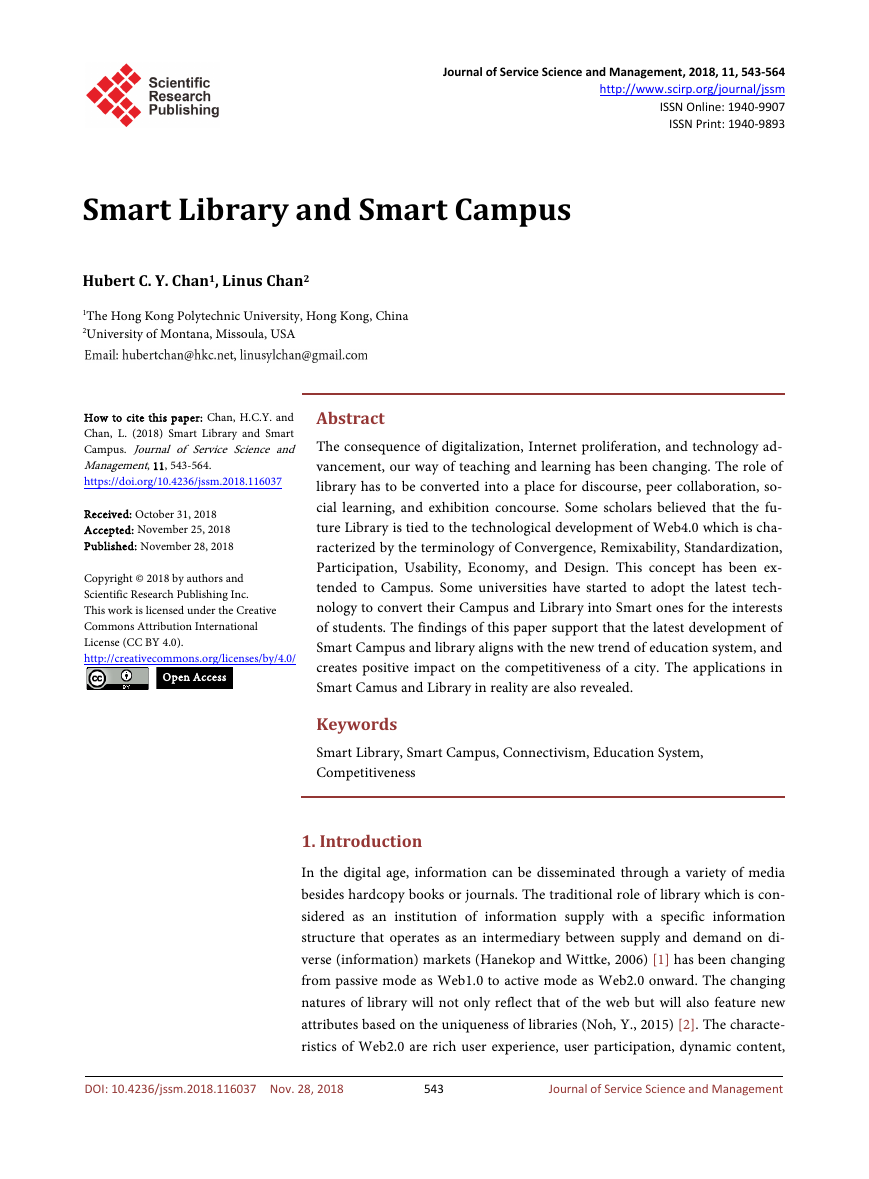


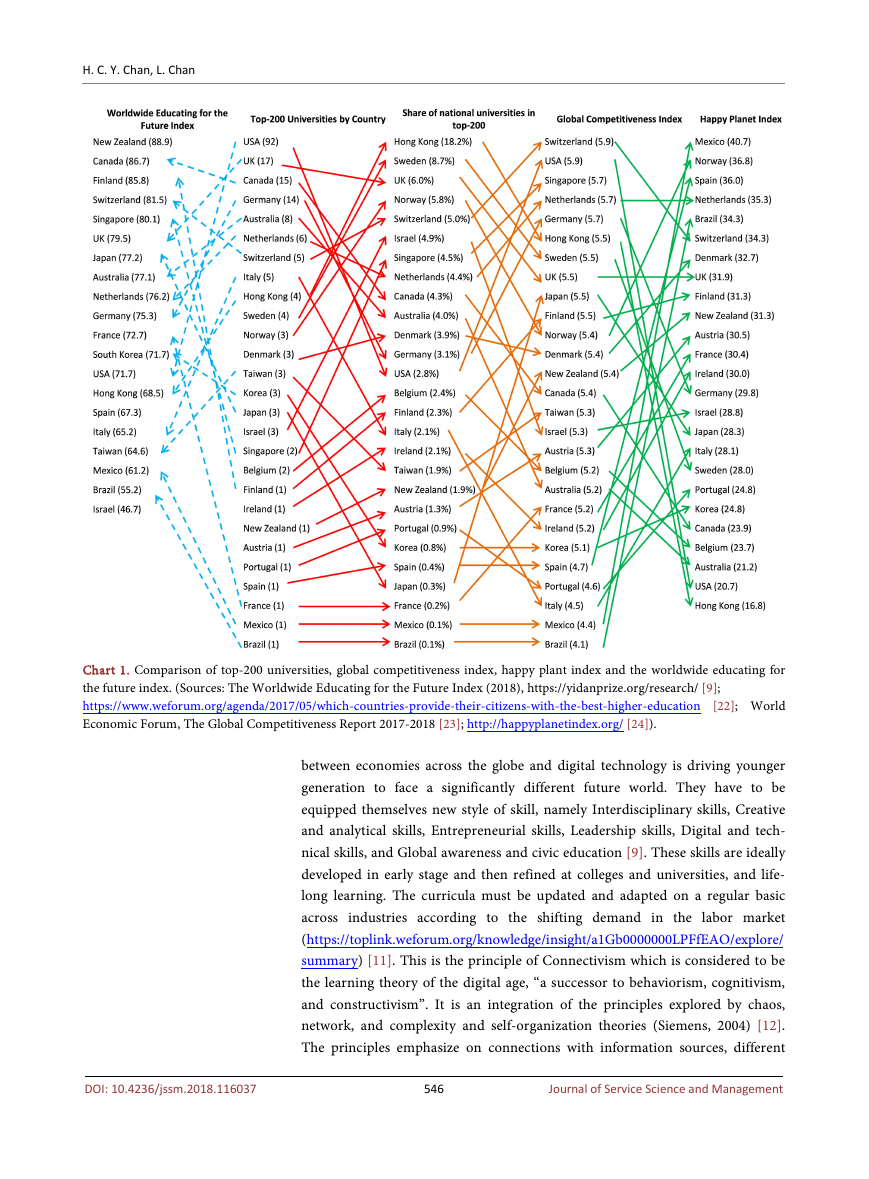
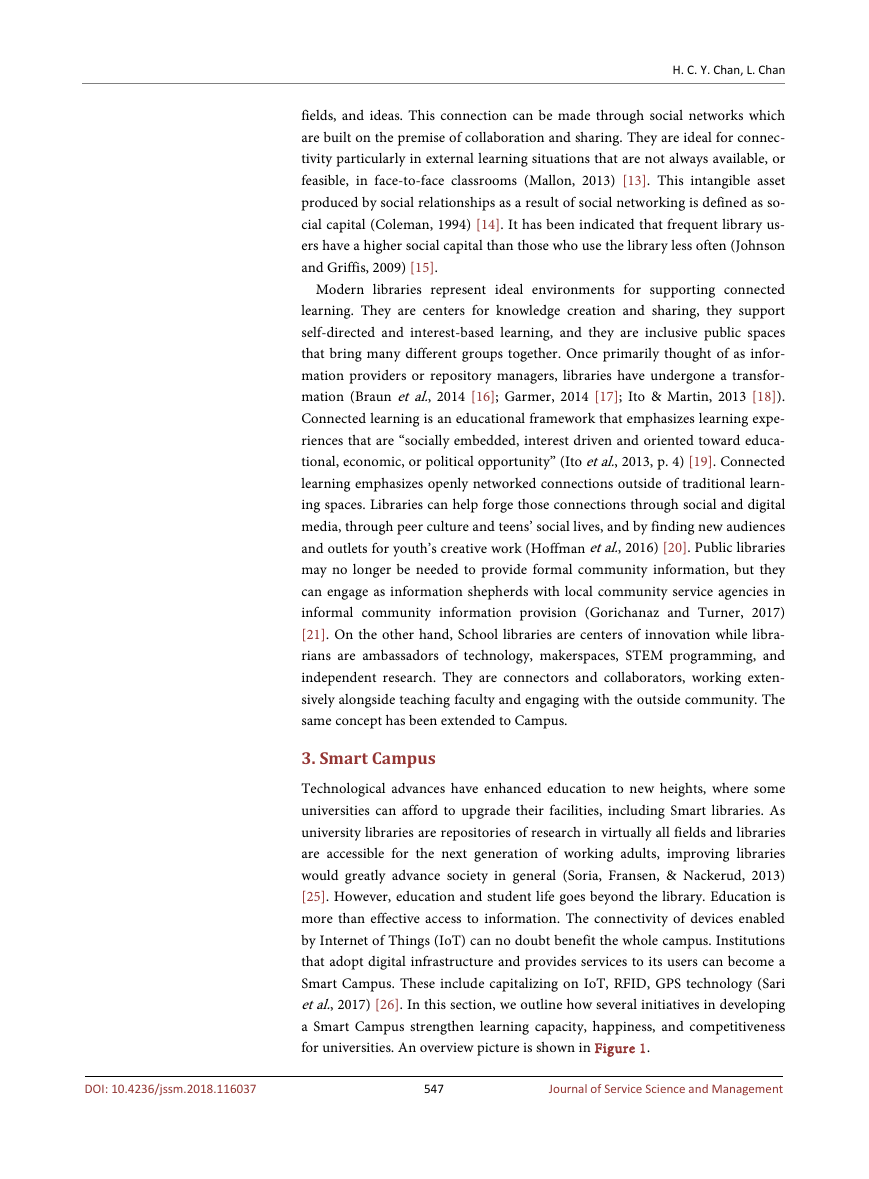
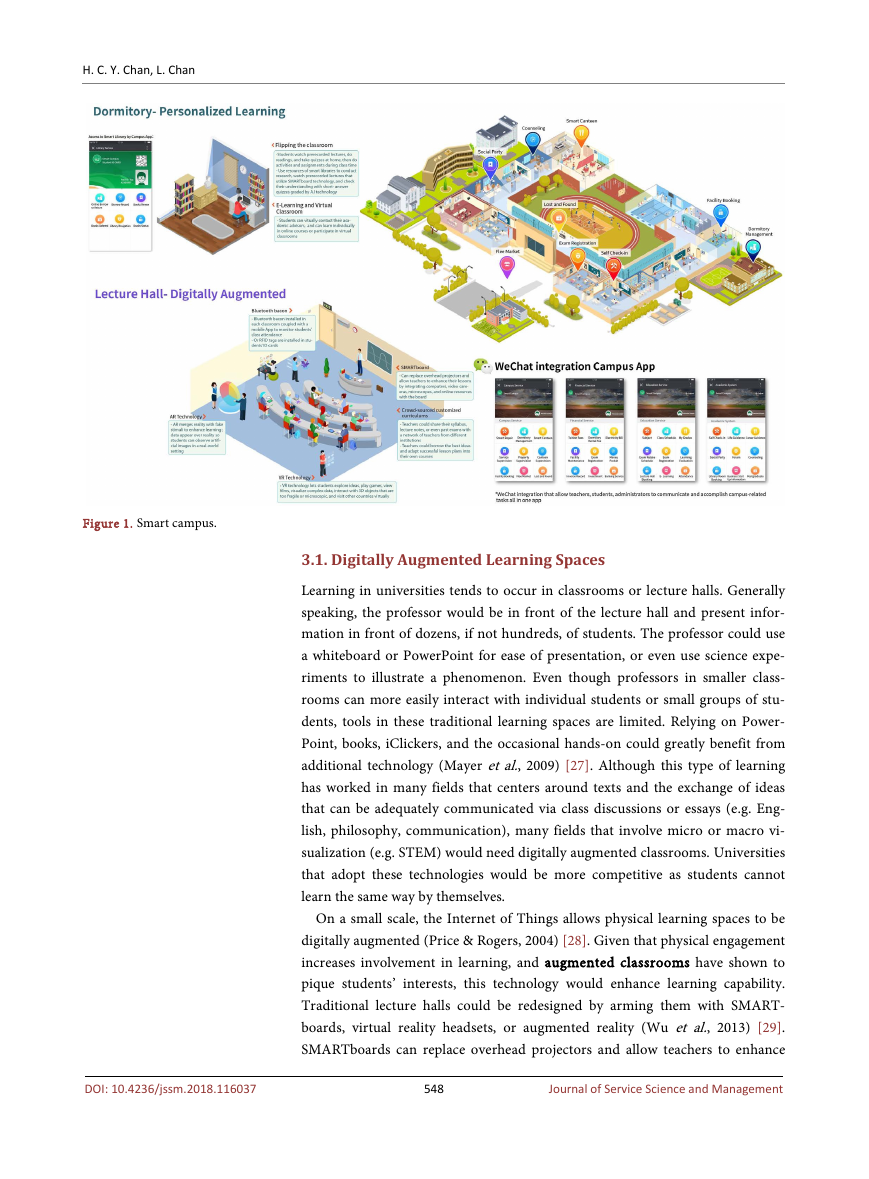

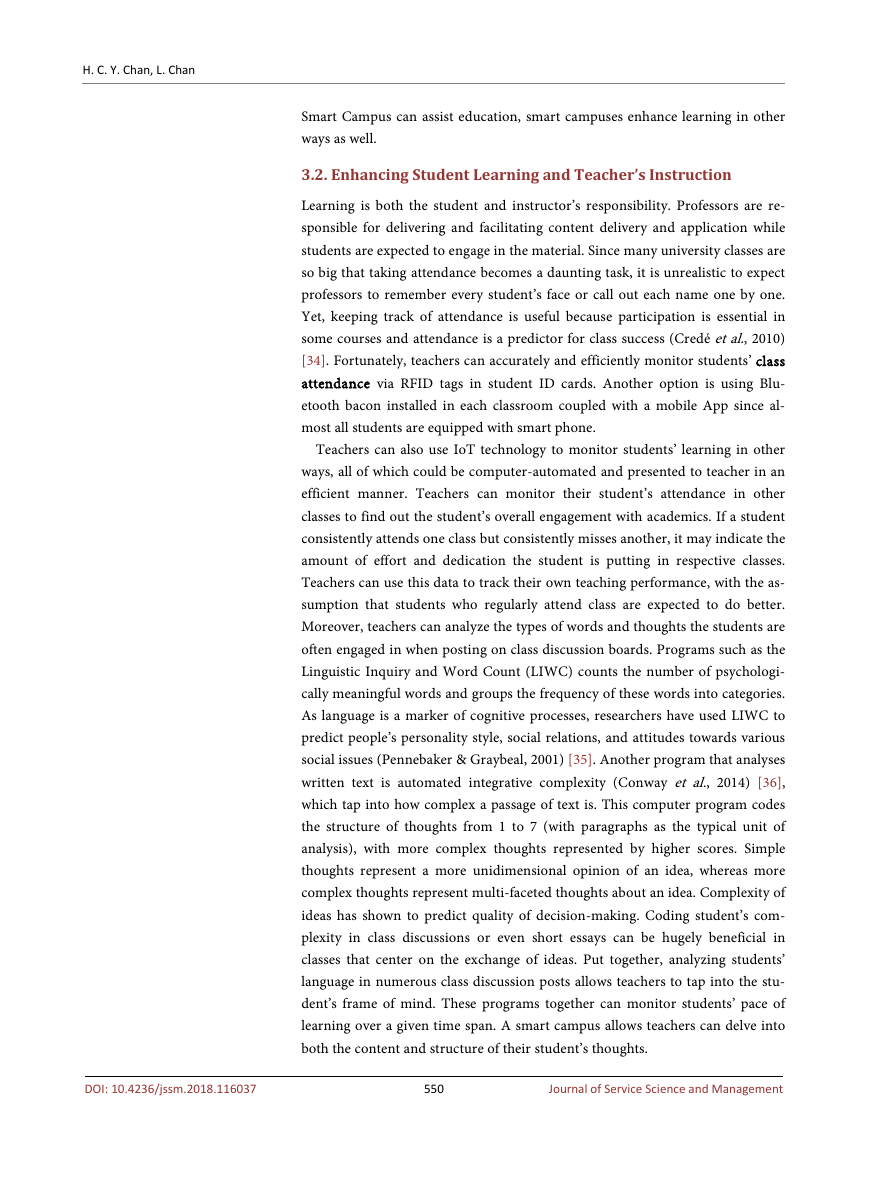








 2023年江西萍乡中考道德与法治真题及答案.doc
2023年江西萍乡中考道德与法治真题及答案.doc 2012年重庆南川中考生物真题及答案.doc
2012年重庆南川中考生物真题及答案.doc 2013年江西师范大学地理学综合及文艺理论基础考研真题.doc
2013年江西师范大学地理学综合及文艺理论基础考研真题.doc 2020年四川甘孜小升初语文真题及答案I卷.doc
2020年四川甘孜小升初语文真题及答案I卷.doc 2020年注册岩土工程师专业基础考试真题及答案.doc
2020年注册岩土工程师专业基础考试真题及答案.doc 2023-2024学年福建省厦门市九年级上学期数学月考试题及答案.doc
2023-2024学年福建省厦门市九年级上学期数学月考试题及答案.doc 2021-2022学年辽宁省沈阳市大东区九年级上学期语文期末试题及答案.doc
2021-2022学年辽宁省沈阳市大东区九年级上学期语文期末试题及答案.doc 2022-2023学年北京东城区初三第一学期物理期末试卷及答案.doc
2022-2023学年北京东城区初三第一学期物理期末试卷及答案.doc 2018上半年江西教师资格初中地理学科知识与教学能力真题及答案.doc
2018上半年江西教师资格初中地理学科知识与教学能力真题及答案.doc 2012年河北国家公务员申论考试真题及答案-省级.doc
2012年河北国家公务员申论考试真题及答案-省级.doc 2020-2021学年江苏省扬州市江都区邵樊片九年级上学期数学第一次质量检测试题及答案.doc
2020-2021学年江苏省扬州市江都区邵樊片九年级上学期数学第一次质量检测试题及答案.doc 2022下半年黑龙江教师资格证中学综合素质真题及答案.doc
2022下半年黑龙江教师资格证中学综合素质真题及答案.doc